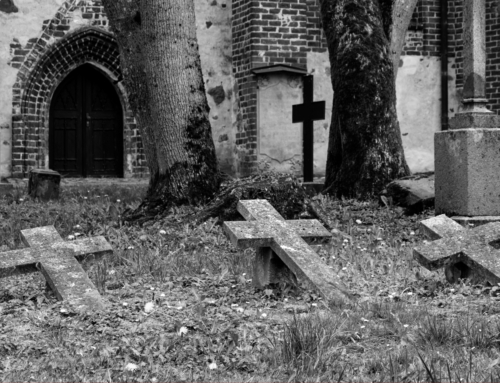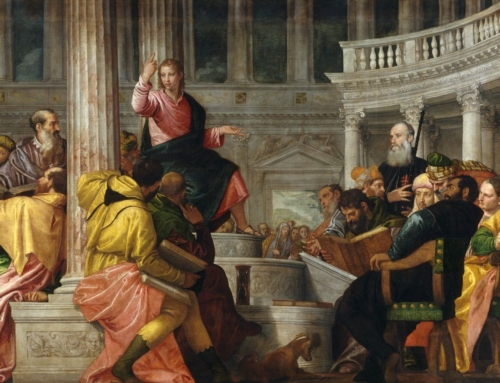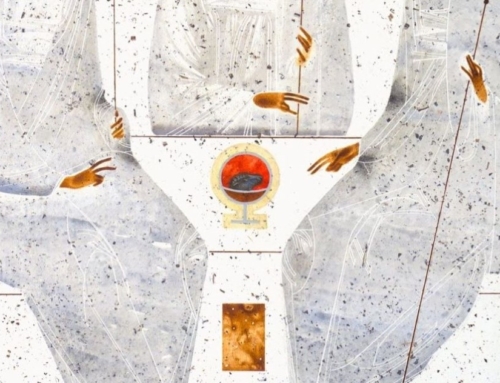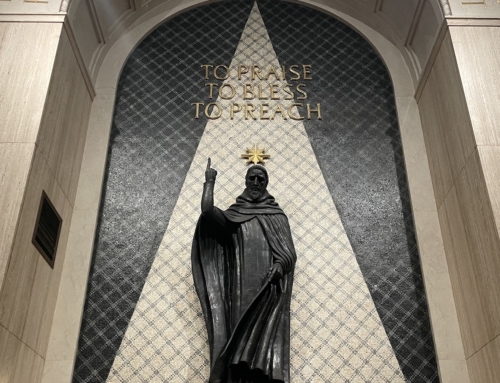What a long, strange trip it’s been, hasn’t it?
Yesterday we kept the feast of the Annunciation of the Lord, usually celebrated on the day nine months before Christmas. The Word through whom all things were created enters His creation just like any child—at the beginning, in the womb of His mother. But this year, when the usual date of March 25th coincided with Good Friday, the celebration of the Incarnation was pushed to the next available day. Because of overlapping liturgical commemorations, we could conclude that the landscape of time has been altered.
During the Easter Octave last week, for eight days the liturgies of Lauds and Vespers used the same exact Psalms, and each day we proclaimed, “This is the day the Lord has made; let us rejoice and be glad in it!” (Ps. 118:24). Not these are the days, but this is the day; the eight days are treated as one as we commemorate the Resurrection of the Lord, as if we were traveling at 99.2% of the speed of light, or transported to a planet with a gravitational field so strong that it has the same effect (as seen with the explorers in the movie Interstellar). The magnitude, or gravity, of the event of Jesus’s rising from the dead thus gives the effect that time is dilated.
As if that weren’t enough, before the Octave we kept the Paschal Triduum in honor of the saving and sacrificial death of Jesus on the Cross and the time that His body lay in the tomb. After the beginning of the Mass of the Lord’s Supper on Holy Thursday and until the final blessing and dismissal at the Mass of the Easter Vigil, the main liturgies have no introduction and no dismissal. Furthermore, in the traditional Dominican way of celebrating the Divine Office, the Offices of prayer during this time lack the customary beginning and end. And for the whole Western Church, the solemn liturgies even supplant some of the Offices, as the entire liturgy of the Triduum comprises a single action in commemoration of the Paschal Mystery. As the Carthusians say, “The Cross stands still while the world turns.” Thus we who stand near the Cross likewise experience time standing still.
Now that the course of time seems to return to normal today, we might ask, “what does this non-linear stretching of the fabric of time mean?” Are we transported back in time when we hear “that is, today” when referring to the institution of the Eucharist on Holy Thursday, or “this is the night” in reference to Israel’s crossing of the Red Sea and the Resurrection of Jesus at the Easter Vigil? These events alert us to the mystery that time is not what it seems, for “with the Lord one day is like a thousand years, and a thousand years like one day” (2 Pt 3:8).
The Greek language contains two words for “time”: chronos, meaning the usual, linear flow of time as measured by clocks and the motions of the cosmos, and kairos, a more transcendent sense of time that refers to an occasion rather than a duration. From the “acceptable time” of repentance (2 Cor 6:2) to keeping watch “at all times” (Lk 21:36), the usage of time signified by kairos abounds in the New Testament. The philosopher-theologian Pseudo-Dionysius spoke of the passage of time as procession, in which everyone participating keeps the same view while passing by at a constant rate, while God watches as if from the peak of a mountain and sees the entire procession at once. This God’s-eye view is therefore outside the normal course of time, and these recent liturgical events—whether time is altered, dilated, or stopped—invite us to consider and participate in the same divine perspective.
For while our lives run their courses from day to day, we can always keep in mind the events of our salvation that changed the course of liturgical time: the Incarnation, Crucifixion, and Resurrection of Jesus Christ. As we continue to keep the Easter Season, let us look beyond the linear flow of time, even while we live in it, and aim to follow the risen Christ into the great day of eternity, for He is “the same yesterday, today, and forever” (Heb 13:8).
✠






